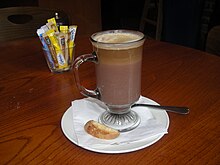Caffè mocha: Difference between revisions
Makecat-bot (talk | contribs) m r2.7.3) (Robot: Adding lt:Caffè mocha |
No edit summary |
||
| Line 3: | Line 3: | ||
[[File:Mocha Latte Costa Rica.JPG|right|thumb|Mocha Latte in Costa Rica]] |
[[File:Mocha Latte Costa Rica.JPG|right|thumb|Mocha Latte in Costa Rica]] |
||
A '''caffè mocha''' or '''café mocha'''<ref group="note">As elsewhere in coffee naming, the Italian ''caffè'' and French ''café'' are commonly found, as are the [[hyperforeignism]]s (errors) ''caffé'' and (sometimes) ''cafè,'' which confuse the accents. Also, in Italian, the correct spelling is ''Moka'', used both for the city and the [[Moka pot]]. "[[Mocha, Yemen|Mocha]]", {{IPA-ar|ˈmoχæ|<!--Yemeni Arabic-->}} by contrast, is from [[Yemeni Arabic]]. [[Starbucks]] uses the Italianate ''caffè mocha''.</ref> |
A '''caffè mocha''' or '''café mocha'''<ref group="note">As elsewhere in coffee naming, the Italian ''caffè'' and French ''café'' are commonly found, as are the [[hyperforeignism]]s (errors) ''caffé'' and (sometimes) ''cafè,'' which confuse the accents. Also, in Italian, the correct spelling is ''Moka'', used both for the city and the [[Moka pot]]. "[[Mocha, Yemen|Mocha]]", {{IPA-ar|ˈmoχæ|<!--Yemeni Arabic-->}} by contrast, is from [[Yemeni Arabic]]. [[Starbucks]] uses the Italianate ''caffè mocha''.</ref> |
||
({{IPAc-en|icon|ˈ|m|ɒ|k|.|ə}} or {{IPAc-en|ˈ|m|oʊ|k|.|ə}}) is a variant of a caffè [[latte]], inspired by the [[Turin]] Coffee beverage [[Bicerin]].{{citation needed|date=March 2012}} Like a |
({{IPAc-en|icon|ˈ|m|ɒ|k|.|ə}} or {{IPAc-en|ˈ|m|oʊ|k|.|ə}}) is a variant of a caffè [[latte]], inspired by the [[Turin]] Coffee beverage [[Bicerin]].{{citation needed|date=March 2012}} Like a caffè latte, it is based on espresso and hot milk, but with added chocolate, typically in the form of sweet [[cocoa powder]], although many varieties use [[chocolate syrup]]. Mochas can contain dark or milk chocolate. |
||
Like [[cappuccino]], café mochas contain the well-known milk froth on top, although they are sometimes served with whipped cream instead. They are usually topped with a dusting of either [[cinnamon]] or cocoa powder |
Café mocha, in its most basic formulation, can also be referred to as [[hot chocolate]] with (e.g. a shot of) espresso added. Like [[cappuccino]], café mochas typically contain the well-known milk froth on top, although, as is common with hot chocolate, they are sometimes served with whipped cream instead. They are usually topped with a dusting of either [[cinnamon]] or cocoa powder and [Marshmallows]] may also be added on top for flavor and decoration. |
||
A variant is white café mocha, made with [[white chocolate]] instead of milk or dark. There are also variants of the drink that mix the two syrups; this mixture is referred to by several names, including black and white mocha, tan mocha, marble mocha, tuxedo mocha and zebra. |
A variant is white café mocha, made with [[white chocolate]] instead of milk or dark. There are also variants of the drink that mix the two syrups; this mixture is referred to by several names, including black and white mocha, tan mocha, marble mocha, tuxedo mocha and zebra. |
||
Revision as of 19:06, 18 December 2012



A caffè mocha or café mocha[note 1] (/[invalid input: 'icon']ˈmɒk.ə/ or /ˈmoʊk.ə/) is a variant of a caffè latte, inspired by the Turin Coffee beverage Bicerin.[citation needed] Like a caffè latte, it is based on espresso and hot milk, but with added chocolate, typically in the form of sweet cocoa powder, although many varieties use chocolate syrup. Mochas can contain dark or milk chocolate.
Café mocha, in its most basic formulation, can also be referred to as hot chocolate with (e.g. a shot of) espresso added. Like cappuccino, café mochas typically contain the well-known milk froth on top, although, as is common with hot chocolate, they are sometimes served with whipped cream instead. They are usually topped with a dusting of either cinnamon or cocoa powder and [Marshmallows]] may also be added on top for flavor and decoration.
A variant is white café mocha, made with white chocolate instead of milk or dark. There are also variants of the drink that mix the two syrups; this mixture is referred to by several names, including black and white mocha, tan mocha, marble mocha, tuxedo mocha and zebra.
Café mocha takes its name from the Red Sea coastal town of Mocha, Yemen, which as far back as the fifteenth century was a dominant exporter of coffee, especially to areas around the Arabian Peninsula.
The caffeine content is approximately 10.9 mg/oz (370 mg/L), which is 175 mg for a 16 oz glass.[1]
Mocha coffee beans
Mocha is also used to describe a type of coffee bean. Smaller and rounder than most other varieties, these beans are derived from the coffee species Coffea arabica, which is native to Ethiopia and Yemen. Although the beans originally shipped from the port of Mocha were thought to have had a chocolate-like taste, current mocha beans from Yemen do not.[2]
Thus, "Mocha coffee" can refer either to the coffee-with-chocolate drink, or simply to coffee brewed with mocha beans.
Notes
- ^ As elsewhere in coffee naming, the Italian caffè and French café are commonly found, as are the hyperforeignisms (errors) caffé and (sometimes) cafè, which confuse the accents. Also, in Italian, the correct spelling is Moka, used both for the city and the Moka pot. "Mocha", [ˈmoχæ] by contrast, is from Yemeni Arabic. Starbucks uses the Italianate caffè mocha.
References
- ^ "Caffeine Content of Drinks". Retrieved June 4, 2010.
- ^ Corby Kummer. The Joy of Coffee: The Essential Guide to Buying, Brewing, and Enjoying. 2003, p. 132

